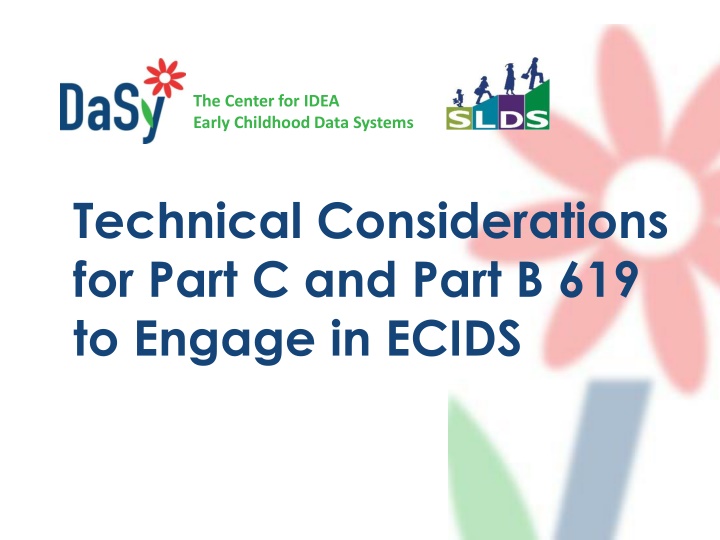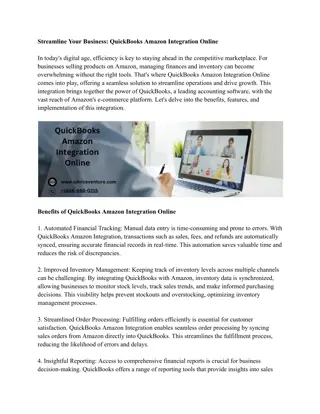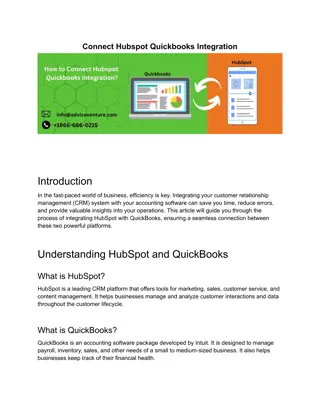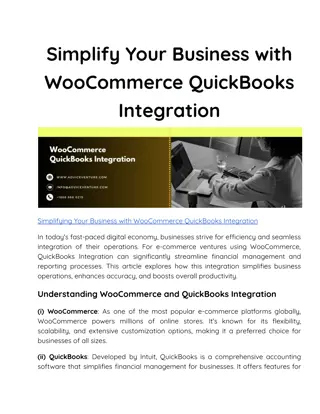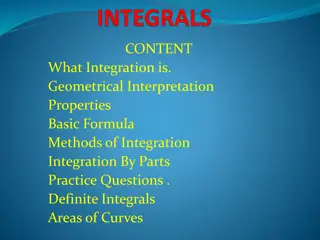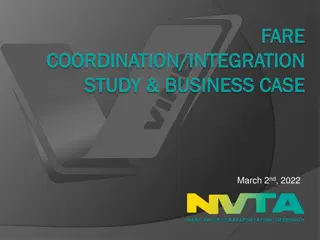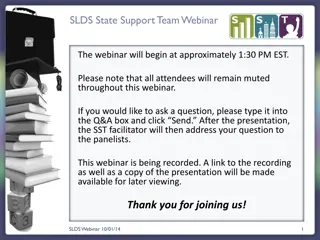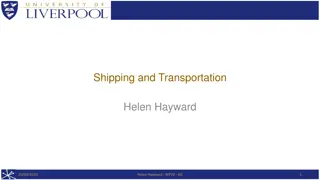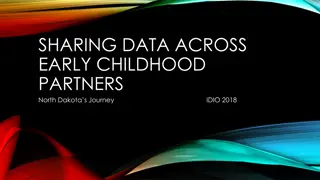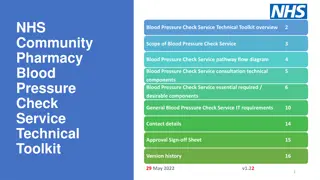Technical Considerations for ECIDS Integration
This webinar outlines key technical considerations for integrating early intervention and early childhood special education data into an Early Childhood Integrated Data System. Learn about preparing data, the ECIDS model components, data use, access, and security considerations.
Download Presentation

Please find below an Image/Link to download the presentation.
The content on the website is provided AS IS for your information and personal use only. It may not be sold, licensed, or shared on other websites without obtaining consent from the author.If you encounter any issues during the download, it is possible that the publisher has removed the file from their server.
You are allowed to download the files provided on this website for personal or commercial use, subject to the condition that they are used lawfully. All files are the property of their respective owners.
The content on the website is provided AS IS for your information and personal use only. It may not be sold, licensed, or shared on other websites without obtaining consent from the author.
E N D
Presentation Transcript
The Center for IDEA Early Childhood Data Systems Technical Considerations for Part C and Part B 619 to Engage in ECIDS
Brief This webinar outlines the topical workgroup brief collaboratively authored by: Tony Ruggiero Jeff Sellers Bill Blandford Nancy Copa Missy Cochenour 2
Presenters This webinar is presented by: Missy Cochenour Jeff Sellers Bill Blandford 3
Introduction Today we will outline technical considerations needed to make informed decisions about integrating early intervention and early childhood special education data into an Early Childhood Integrated Data System (ECIDS). States are recognizing the increasing need to use data to answer policy questions and guide program improvement efforts. A considerable number of these questions are difficult to answer using any single early childhood program data alone. As a result, many Part C and Part B 619 programs are now participating in cross- agency data system initiatives such as ECIDSs. 4
Intended Outcomes After engaging in the webinar, participants will be able to: gain a better understanding of technical considerations for preparing data for integration into an ECIDS understand the different components of the ECIDS data system model determine ECIDS considerations for data use, data system access, and data system security 5
ECIDS Funding cuts across Federal programs RTT-ELC States ECIDS Round 1 RTT-ELC States ECIDS Round 2 RTT-ELC States ECIDS Round 3 States Using SLDS for ECIDS EC Specific (U.S. Virgin Islands) States Using SLDS Grant to Include EC in P-20 States Using Internal Resources for ECIDS ECCS Grant Toward ECIDS (Utah) States Not Working Toward an ECIDS For more information on what an ECIDS is click here 8
1. Technical considerations for preparing your data for integration into an ECIDS Where do you start? What is the purpose for integrating data? Refer to the DaSy Framework Identify the questions you need to answer with ECIDS data 9
Consideration 1a: What are the critical questions you want to answer for your Part C and Part B 619 program and what data elements from the programs collectively contributing to the ECIDS are needed to answer those questions? Critical questions serve as the guide for data-informed decision- making Consider which questions can only be answered with access to data from other early childhood programs Once you have developed your questions, consider the specific data elements needed to answer each one. States can use the Common Education Data Standards (CEDS) Connect tool to define and operationalize their critical questions by determining the necessary data elements and defining the analysis steps for using those elements to answer the questions. For more information on CEDS Connect and how it can help define critical questions, visit the CEDS Connect website at: https://ceds.ed.gov/ https://ceds.ed.gov/. 10
Consideration 1b: Which data elements should be included in the ECIDS? Aim for including any element that can help you answer critical questions that cannot be answered with the current data systems Consult the data dictionary for the ECIDS The data dictionary should include data element definitions and other information to consider in the integration process 11
Consideration 1c: How will the authoritative source (or single source of truth) be determined? A well-designed ECIDS stores each data element only once (i.e., in no more than a single row of a single table), which is known as having an authoritative source, or single source of truth. For example, both Part C and Part B 619 datasets likely contain a field for child/student physical home address. When adding these data to the ECIDS, a single authoritative source of that information must be selected and used. The single source of truth can be determined by the quality of the data, the context in which an element is collected, and by creating a composite view of a record. Ultimately this decision is made with the ECIDS data governance body 12
Consideration 1d: How many years of data are needed and when can updated data be provided? (Timeliness) Once you have identified the data elements you want to include in the ECIDS, you must decide how many years of those data you need Regardless of whether or not the time frame is predetermined, be sure to think about: data availability e.g. the ECIDS plan calls for data beginning with school year 2005 and a program data source only has data beginning with school year 2008 data quality e.g. consider the completeness of the data sets; are all jurisdictions represented for every year of the data changes in data e.g. data elements have changed over time, possibly due to new regulations or reporting requirements 13
2. Technical considerations for understanding the ECIDS data system model How will the data system model selected by the state influence the integration process itself The data system model determines who controls the original data source what it will take to integrate data into the ECIDS any transformation rules that need to be applied 16
Consideration 2a: Which data system model is your state using for its ECIDS? A clear understanding of the data system model your state is using to develop its ECIDS will improve the various data contributors ability to discuss how the system can (or cannot) meet individual program needs. 17
Centralized ECIDS Model early childhood data from across all participating programs and agencies is generally consolidated into one database or data warehouse from the beginning 18
Centralized ECIDS Model Strengths of a centralized model include queries and reports can be run easily and in a timely manner; the system produces consistent data; and a wider range of short-term and long-term report categories are possible. Weaknesses of a centralized model include the consolidated database requires extensive support, including a database administrator, storage, server, etc.; and public concern about all child and personally identifiable information being stored in one place or misused. 19
Federated ECIDS Model Each program or agency feeds appropriate data into the ECIDS from their own data sources. Linkages used to match data from different sources do not persist under a federated model. 20
Federated ECIDS Model Strengths of a federated model include there is no costly, centralized database to support; fewer resources are needed; and there are fewer concerns about storing all child-level data in a central location. Weaknesses of a federated model include the challenge of determining longitudinal cohorts across data systems; the system can only produce data files long-term and stored data sets are not available; and the system is unable to produce reports with persistent data linkages. 21
Hybrid ECIDS Model As in a federated model, each program or agency feeds appropriate data into the ECIDS directly from its own data source. The key difference from a federated model is that matching linkages persist in a hybrid model. 22
Hybrid ECIDS Model Strengths of a hybrid model include the matching process is done only once; persisting linkages cut down on processing time; and there no need for a large central database, and limited support is needed for the match database. The primary weakness of a hybrid model is that it faces similar reporting and cohort-defining challenges as a federated model. 23
Consideration 2b: What will it take to integrate data into the ECIDS? Integrating the data is a process that goes beyond establishing linkage between data sets. Transformation of data for seamless integration: E.g. the data element GENDER code set is M & F in the ECIDS, but it is Male & Female in the program source system. The data must be transformed as they are loaded into the ECIDS, changing Male to M and Female to F Are there data for which it would be beneficial to transform raw values into calculated values? E.g. using date of birth and exit date to calculate the age of a child at exit from a program 24
Consideration 2c: What process or method will be used to match and load individual data? Establish a standard and systematic process or method to reliably match records between the source system and the ECIDS Data can be matched by: using a single field (e.g., unique student identifier) a more complex matching algorithm, such as a weighted algorithm of combined demographic fields (e.g., name, SSN, date of birth, gender, etc.) 25
Consideration 2d: How will the data be stored in the ECIDS? Depends largely on the model being used for the ECIDS. Understanding how and for how long data are stored will help define what types of questions can be answered. For example, if data are only stored for a short period of time, long-range longitudinal questions cannot be answered. In a centralized model, the data are copied into a centralized data repository, which can allow for a wider array of questions to be answered. In a federated model, the data are most likely not stored in any capacity. In most federated systems, data linkages do not persist, but the specific query requiring an integrated data set only exists for the specific data request and then is deleted. A hybrid (combination of centralized and federated) ECIDS will typically only store data for a limited time, which would limit the types of questions a program can answer. 26
3. Technical considerations for data use, access, and security A data user as any person who accesses or is provided the data in any form, including raw data, data tables, data displays, reports, or any other data products. Data governance policies for both the data contributors and ECIDS must be adhered to. The data system s purpose and vision must be sensitive to: protection of personally identifiable information (PII) privacy security appropriate access 29
Consideration 3a: Why is it important to create an ECIDS data dictionary? A data dictionary contains a description of each data element in a data system, e.g. name, type, definition, how relates to other data Translates data elements into real- world terms Helps users prepare data elements to be compared or merged with data from other systems. ABCs of Data Dictionaries 30
Consideration 3b: What functionality is needed to conduct the types of data analyses required to answer your program s critical questions? Data analytic functionality can range from simple on-screen predefined (or canned ) reports to rich business intelligence capabilities. Think about the types of analyses you may want to conduct with the data in the ECIDS and what you hope to get from the system in terms of reports. Do you want graphical displays in addition to quantitative outputs? Do you want the ability to construct your own customized analysis, with access to all data elements in the system? Do you want the ability to export data for manipulation in another tool, e.g., in CSV or Excel? Bear in mind that not all users will require the same level of access for data analyses. 31
Consideration 3c: How will the data be protected from loss and/or corruption? Integrated data must meet all state, federal, and local privacy/confidentiality regulations/laws. Part C/Part B 619 program staff should be prepared to discuss any concerns or special considerations related to their data. Memoranda of Understanding (MOUs) and/or security documents should include any additional measures, outside of those established for the ECIDS as a whole, required by Part C or Part B 619. Data governance policies will establish measures to ensure data linkages are secure and stable so neither the contributing program s data system nor the ECIDS as a whole is compromised. While each program maintains its own data disaster plan and back-up schedule, an ECIDS should also include a data disaster plan, particularly when a federated or hybrid data model is used. 32
Consideration 3d: What types of user- and data-level security will need to be built into the system design? Different types of ECIDS users may require different security levels to access the data in the system, as well as the ability to conduct different types of analyses. E.g. a Part C Coordinator may require the ability to access from the ECIDS all child-level data for their jurisdiction to conduct data audits and quality checks another participating agency/program administrator may only require access to summary-level data for aggregated analyses. Defining user security levels and how those levels will be granted within the ECIDS are critical steps in the design of the system for protecting data from unauthorized access and unintended use. 33
Consideration 3e: How are levels of access determined and granted within the ECIDS for de-identified and identifiable information (as appropriate)? To ensure that users are granted access to child-level data, while maintaining security and privacy, roles are established within the ECIDS to provide needed access Granting and administering user accounts should be handled from the top down Expiration of access can also be automated for users with long periods of account inactivity For external users, such as researchers, it is recommended practice to have them formally request access and adhere to For more information about early childhood data privacy topics, visit the Privacy Technical http://ptac.ed.gov/early-childhood-data-privacy Assistance Center s website at: http://ptac.ed.gov/early- childhood-data-privacy http://ptac.ed.gov/early-childhood-data-privacy FERPA regulations for data use 34
Consideration 3f: What technical infrastructure is in place to ensure privacy of the program data? When storing the data, the ECIDS team should ensure the system adheres to application and data security best practices Data should be stored on a secure hosting environment with servers that receive regular security and vulnerability maintenance A web security layer that encrypts the flow of data between the system and user should be implemented Maintenance policies and procedures should be established to periodically test the integrity of the privacy features of the program data Privacy Technical Assistance Center (PTAC) http://ptac.ed.gov/ 35
Summary So what? When participating in an ECIDS, Part C and Part B 619 staff need to consider the preparation it takes to integrate their data, the ECIDS model that will be used to integrate their data, and data use, access, and security policies/procedures that will govern their data. With an understanding of these technical considerations, Part C and Part B 619 staff will be able to make informed decisions as members of an ECIDS team. This understanding will facilitate communication with other ECIDS partners and increase the likelihood that Part C and Part B 619 staff will be get what they need from the data system. 37
Resources DaSy Framework ECIDS Toolkit Which ECIDS System Model is Best for our State ECIDS? Introduction to ECIDS System Design The Basics 101 ABCs of Data Dictionaries Privacy Technical Assistance Center 39
